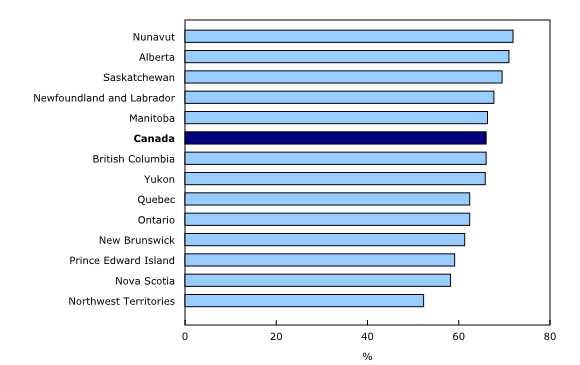Remaining useful service life ratios of non-residential capital stock, 2009 to 2014
Archived Content
Information identified as archived is provided for reference, research or recordkeeping purposes. It is not subject to the Government of Canada Web Standards and has not been altered or updated since it was archived. Please "contact us" to request a format other than those available.
Released: 2017-05-15
The ratio of Canadian non-residential capital stock's remaining useful service life was 66.0% in 2014 compared with 63.7% in 2009, the first year for which data are available. This increase was due to significant and regular investments, particularly in non-residential engineering assets such as oil and gas production facilities, mining engineering construction and electric power engineering construction.
The remaining useful service life ratio of total non-residential engineering capital stock rose from 66.5% in 2009 to 70.0% in 2014, reflecting in particular the continued investments in oil and gas production facilities over this period.
The three asset categories that form Canada's infrastructure foundation are waterworks engineering, sewage engineering, and highways, roads, streets, bridges and overpasses. From 2010 to 2014, they received roughly $135.7 billion in investment, an average of $27.1 billion per year, up 10% from the $24.6 billion invested in 2009. This resulted in higher remaining useful service life ratios at the national level for highways, roads, streets, bridges and overpasses, from 63.8% in 2009 to 65.9% in 2014; and also for waterworks engineering construction, from 69.5% in 2009 to 72.9% in 2014. The sewage engineering construction ratio remained stable at 63.2% over the same period.
Investment up in nine provinces and territories
Nine provinces and territories showed improvements in their remaining useful service life ratios. In 2014, this ratio ranged from 52.3% in the Northwest Territories to 71.9% in Nunavut.
With the strength of the oil and gas subsector over this period, the resource-based provinces of Alberta (71.0%), Saskatchewan (69.5%) and Newfoundland and Labrador (67.7%) posted ratios above the Canadian average in 2014. These three provinces had the highest remaining useful service life ratios among the provinces and territories following Nunavut. While Nunavut's ratio fell from 2009 to 2014, it remained the highest in Canada.
The lowest remaining useful service life ratios were in the Northwest Territories and the Maritimes, and these ratios edged down from 2009 to 2014 except in Nova Scotia, where the ratio improved to 58.2%.
Remaining useful service life of infrastructure improves in most provinces and territories
The ratio for highways, roads, streets, bridges and overpasses increased in most provinces and territories from 2009 to 2014. Alberta (71.8%) and Saskatchewan (67.3%) led the gains, with their ratios increasing by more than 7% from 2009. The ratio in Prince Edward Island fell from 53.0% in 2009 to 49.3% in 2014, as it continued to have the lowest remaining useful service life ratio among the provinces and territories.
The ratio for waterworks engineering increased the most in Yukon, improving from 59.5% in 2009 to 71.6% in 2014, while Ontario had the smallest improvement, up about 2% to 75.6%. The ratio of Nunavut's (79.1%) waterworks engineering assets are the youngest in Canada, due to higher recent investment relative to the past.
After peaking at 64.2% in 2012, the ratio of sewage engineering returned to its 2009 level of 63.2% in 2014. The remaining useful service life ratio for sewage engineering in Alberta reached 72.0% in 2014, making it the youngest in Canada, while Prince Edward Island had the lowest ratio at 48.3%.
Products
The article, "Remaining useful service life ratios of non-residential capital stock", which is part of Income and Expenditure Accounts Technical Series (13-604-M), is now available.
The System of Macroeconomic Accounts module features an up-to-date portrait of national and provincial economies and their structure.
The Methodological Guide: Canadian System of Macroeconomic Accounts (13-607-X) is also available.
The User Guide: Canadian System of Macroeconomic Accounts (13-606-G) is also available.
Contact information
For more information, or to enquire about the concepts, methods or data quality of this release, contact us (toll-free 1-800-263-1136; 514-283-8300; STATCAN.infostats-infostats.STATCAN@canada.ca) or Media Relations (613-951-4636; STATCAN.mediahotline-ligneinfomedias.STATCAN@canada.ca).
- Date modified:


